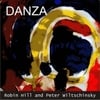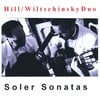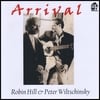I was absolutely delighted when 'Danza' by The Hill/Wiltschinsky Guitar duo, became available for us to re-release.
Initially recorded and distributed by ASV back in 1995, it had however never been digitally available, so now was our chance to rectify this.
I was also very pleased because this CD happens to be one that means a lot to me.
At the time of its release I was frequently travelling with the duo, as Robin and I were yet to have children... and therefore have seen and heard most of these tracks performed in concert venues around the world.
Before I add a contemporary review of 'Danza' from 'Classical Guitar Magazine' and the eloquent and detailed sleeve notes from the original release, written by Graham Wade, I wanted to add a little inside information.
For example, Tracks 20 is the fabulous, 'Corta Jaca' by Radames Gnattali, taken from the Retratos Suite, this is a stunning piece based on the samba rhythm.
At the time the music was unavailable but the duo were desperate to play it. So, determined as ever, Robin listened to the only recording available and took down the notes one at a time.
As you hear the piece you will realise just what an undertaking this was!
But, worth all the effort as they gave many fabulous performances along with this recording.
I also wanted to mention the, 'Suite Italiana' by Mario Gangi.
Gangi had heard a recording of the duo playing another of his pieces, 'Suite Spagnola' and was so pleased with their interpretation that he composed the 'Suite Italiana' especially for them.
One review at the time of an important concert by the Duo at Rome's Sistine Theatre, in homage to Andres Segovia, mentions that the journalist involved happened to be seated next to Maestro Gangi and that Gangi was, "hardly able to hide his satisfaction for the lovely performance."
'Espagne', composed by the brilliant French guitarist Ida Presti, is the world premiere recording of this piece. The duo, having heard a tape recording of an old radio performance by the Presti and Lagoya Duo, were keen to record and perform this neglected masterpiece. It provides a spectacular demonstration of guitar virtuosity and compositional inventiveness.
The final piece I would like to mention is Robin's own composition, 'Tre Esercizi' (dedicated to Mario Gangi in reciprocity for the Suite Italiana) comprises three movements, Tarantella in E minor (track 8), Canzone in F (track 9) and Giga in A minor (track 10).
The review below, from 'Classical Guitar' states that 'Canzone' contains, "one of those compulsive melodic lines we all wish we'd written ourselves," but it's the, Giga in A minor that I want to highlight.
The main reason being that when performing this in concert Peter Wiltschinsky always introduced this as being, "One of the most difficult pieces we play," which always induced a little laughter from the audience and a sense of trepidation as the music began.
I recall the tension I felt as I played every note in my head alongside the duo, willing them to get through the difficult passages!
They always did.
You can find 'Danza' on iTunes, Amazon, CD Baby and many other digital outlets.
Below are the original review and sleeve notes.
DANZA - REVIEW - 'CLASSICAL GUITAR MAGAZINE'
A new release from the Hill-Wiltschinsky Duo is always a cause for celebration, and DANZA is no exception. From the opening bars of the Giuliani to the triumphant conclusion of Gnattali's brilliant Corta Jaca, this world class team remain on their very best form. Even the modest lute duets are despatched with a sense of style and grandeur which belies their relatively humble stature.
It is, however, the premiere recording of Presti's Espagne which makes this release such a major event. A momentous discovery by any standards, it will remain forever a mystery why this seven minute Fallaesque fantasia was never taken into the studio by its creator and has languished in obscurity since her death in 1967. Rich in texture and strong in thematic material, it is surely fitting that this neglected masterpiece has finally been adopted by one of the present generation's finest pair. Needless to say, the performance leaves nothing to the imagination - Espagne is typical of the colourful and energetic repertoire in which the Hill-Wiltschinsky Duo always excel.
Elsewhere, the situation remains equally impressive. Robin Hill's recently published Tre Esercizi are marvellously sophisticated miniatures, the central Canzone containing one of those compulsive melodic lines we all wish we'd written ourselves. More introspective is Peter Wiltschinsky's gently seductive Nocturne - a strategically placed moment of contemplation before the boisterous jota-based Danza.
All these delights together with the old favourites from Gangi and Vivaldi make this a CD of which no collection should be deprived.
By Paul Fowles
SLEEVE NOTES BY GRAHAM WADE:
MAURO GIULIANI (1781-1828)
TRE POLONESI CONCERTANTI, Op.137
Giuliani was one of the most celebrated guitarists of the early nineteenth century and his achievement in the realm of composition for the instrument ranks with that of Fernando Sor. Giuliani was a prolific composer and wrote a wide variety of works for guitar including concertos, sets of variations, studies, songs, exercises, chamber music, as well as some pieces for duo. A significant part of his career was spent in Vienna where he was well acquainted with Beethoven, Moscheles, Hummel and other leading musicians. In Italy he knew both Paganini and Rossini and may have performed concerts in their company.
The polonaise appeared in the Renaissance under the title of 'polacca' or 'polnischer tanz'. In the seventeenth century the French term 'polonaise' was used for pieces of Polish style or origin and over some decades this evolved into a professional dance faster than a sarabande but slower than a minuet. As an expressive musical form the polonaise was transformed for ever by Chopin whose genius enriched and elevated the concept in eleven spectacular works for pianoforte between 1817 and 1830.
The three polonaises for two guitars Op.137 were published seven years after Giuliani's death by Ricordi of Milan. The Italian composer's approach to the polonaise is concise and energetic, each of the three allegretto pieces having a contrasting Trio section. Rather than the extended polonaise-fantaisie concept of Chopin, Giuliani offers an integrated group of short polonaises, exploring the rhythmic and lyrical implications of this dance through the medium of the guitar duo.
FOUR ELIZABETHAN LUTE DUETS
One special aspect of music during the reign of Elizabeth I was the variety of ensemble music. The lute duet was especially popular and John Johnson was one of the first to compose for two lutes in an integrated way, both parts being of equal importance in melodic and harmonic material. Johnson became court lutenist to Queen Elizabeth, and was one of the earliest of the great lute composers of the 'golden age'.
The pavan (also known as pavane, pavana, paduana, and pavin) was the slowest, most stately dance of the Renaissance. It was customary after 1550 to pair the dignified pavan with the more lively galliard, a dance of Italian origin, in fast triple time, involving the dancer in energetic leaping steps. In The Flat Pavan, 'flat' indicates not that the music is out of tune but hat it is in a minor key.
The Fancy or Fantasy, was a form which displayed a composer's contrapuntal skills. Thomas Morley said that, 'in this may more art be shown than in any other music because the composer is tied to nothing but that he may add, diminish, and alter at his pleasure'.
Finally A Merry Mood is a moment of exuberance, a very different mood from the melancholy seriousness often associated with the English lutenists.
ROBIN HILL
TRE ESERCIZI
These 'Three Exercises', dedicated to Mario Gangi, evoke the moods and colours of Italian music through the eyes and ears of an English composer.
Tarantella in E minor pays homage to the lively dance from southern Italy where the port of Taranto has given its name to a spider found in the surrounding countryside, the tarantula. The bite of this spider was believed for centuries to be poisonous, causing an ailment known as Tarantism, an illness which could only be dispelled by the antidote of a lively dance, the tarantella.
The Canzone, originally a poem of the troubadour era, later became the title for a musical setting of a poem or an instrumental piece with a distinct melody.
Finally Giga concludes the triptych with a dance, the Jig, believed to have originated in the British Isles before becoming popular throughout Europe.
PETER WILTSCHINSKY
TWO PIECES
These two pieces are dedicated to the memory of the great Paraguayan guitarist and composer, Agustin Barrios Mangore. The first, Nocturne (written 1993), conjures up the shades of night with a reflective and lyrical atmosphere. It is in the key of G minor with a contrasting middle section in G major.
Danza (Jota), in the key of A major, is a virtuosic movement with its energetic variations based on the jota dance of the regions of Aragon and Navarre in northern Spain. The jota has been called the 'father of Spanish dances' and its origins may stretch into antiquity. It is in triple time, and the dance itself is characterised by swift leaps into the air demanding great physical strength and facility.
ANTONIO VIVALDI (1678-1741)
PRELUDIO & CORRENTE
Vivaldi was a much neglected composer until the twentieth century was well advanced when considerable research and catalogue of his works, along with a gradual recording of most of his output, established him as one of the greatest of all Baroque composers. He composed 46 operas (of which 21 are extant), 344 solo concertos, 81 concertos for two or more solo instruments, 61 sinfonias, 93 sonatas and trios, as well as many motets, liturgical works, oratorios, etc.
Preludio & Corrente were arranged for two guitars by Len Williams in the mid 1950s. The two contrasting pieces soon became very popular among guitarists and have remained so ever since. The movements are taken from Sonata in D minor, Op.1 No 8, (RV64, P1/8, M. 389) for two violins and cello (or harpsichord).
MARIO GANGI (1918-2010)
SUITE ITALIANA
Mario Gangi, Professor of guitar at the Rome Conservatoire, is known internationally as a prolific editor and arranger of music for guitar. Suite Italiana was written especially for the Hill-Wiltschinsky Duo in 1988. The Saltarello is a very lively dance in triple time, deriving its name from the Italian word 'saltare', to jump, and according to a note by the composer, inspired by an anonymous saltarello of Rome. The other movements are Melodia, evoking the warmth of a Mediterranean song from the area of Abruzzi, while Tarantella makes reference to a theme from the opera La festa di Piedigrotta (composed 1852) by the Neapolitan, Luigi Ricci (1805-1859), who wrote some 30 operas.
IDA PRESTI (1924-1967)
ESPAGNE
Ida Presti was a remarkable child prodigy of the guitar, who gave her first public recital at the age of eight. In 1955 she formed a guitar duo with her husband, Alexandre Lagoya, and their work together founded new traditions of excellence in this kind of ensemble which continue to inspire later generations of players. Presti was also an accomplished composer, though her works are not widely known.
Espagne has never been recorded previously and its inclusion here offer new insights into her remarkable creativity.
RADAMES GNATTALI (1906-1988)
TWO PIECES
Radames Gnattali was one of the great figures of Brazilian music in this century, composing both popular and classical music, and teaching many of the leading musicians of his country including Jobim, Bonfa, Gilberto, etc. His suite Retratos (Portraits), from which these two pieces were taken, was composed in 1957. The Schottisch is a kind of round dance or slow polka while Corta Jaca is based on the rhythms of the samba.
By Graham Wade
Reviews
'As always, it was sheer pleasure to observe Robin Hill's remarkable fluent technique: everything looks easy when he plays it.' Colin Cooper- Classical Guitar Magazine -----
'Wonderful for their (Hill & Wiltschinsky) precision, touch and clarity of sound... refined virtuosity, the achievement of a long interpretive process.' Il Giornale D'Italia (Rome) -----
'I loved your CD and thought your technique and performance were fabulous...' Rick Wakeman
Wednesday, October 02, 2013
Danza - Robin Hill & Peter Wiltschinsky
Subscribe to:
Post Comments (Atom)


















No comments:
Post a Comment